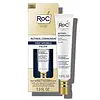What's inside
What's inside
 Key Ingredients
Key Ingredients

 Benefits
Benefits

 Concerns
Concerns

 Ingredients Side-by-side
Ingredients Side-by-side

Water
Skin ConditioningPentaerythrityl Tetraethylhexanoate
EmollientGlycerin
HumectantPEG-8
HumectantPPG-15 Stearyl Ether
EmollientNylon-12
Butylene Glycol
HumectantStearyl Alcohol
EmollientCetearyl Alcohol
EmollientEthylhexyl Methoxycinnamate
UV AbsorberDimethicone
EmollientCyclohexasiloxane
EmollientCeteareth-20
CleansingIsohexadecane
EmollientButyrospermum Parkii Butter
Skin ConditioningRetinol
Skin ConditioningHydrolyzed Hyaluronic Acid
HumectantPolyacrylamide
Phenoxyethanol
PreservativeAmmonium Acryloyldimethyltaurate/Vp Copolymer
Caprylyl Glycol
EmollientPentylene Glycol
Skin ConditioningC13-14 Isoparaffin
EmollientTocopheryl Acetate
AntioxidantLaureth-7
EmulsifyingDisodium EDTA
Allantoin
Skin ConditioningDihydroxy Methylchromone
AntioxidantBHT
AntioxidantCyclopentasiloxane
EmollientHydroxyphenyl Propamidobenzoic Acid
Skin ConditioningAscorbic Acid
AntioxidantPolysorbate 20
EmulsifyingMethylparaben
PreservativeEthylparaben
PreservativePropylparaben
PreservativeParfum
MaskingWater, Pentaerythrityl Tetraethylhexanoate, Glycerin, PEG-8, PPG-15 Stearyl Ether, Nylon-12, Butylene Glycol, Stearyl Alcohol, Cetearyl Alcohol, Ethylhexyl Methoxycinnamate, Dimethicone, Cyclohexasiloxane, Ceteareth-20, Isohexadecane, Butyrospermum Parkii Butter, Retinol, Hydrolyzed Hyaluronic Acid, Polyacrylamide, Phenoxyethanol, Ammonium Acryloyldimethyltaurate/Vp Copolymer, Caprylyl Glycol, Pentylene Glycol, C13-14 Isoparaffin, Tocopheryl Acetate, Laureth-7, Disodium EDTA, Allantoin, Dihydroxy Methylchromone, BHT, Cyclopentasiloxane, Hydroxyphenyl Propamidobenzoic Acid, Ascorbic Acid, Polysorbate 20, Methylparaben, Ethylparaben, Propylparaben, Parfum
Water
Skin ConditioningPropanediol
SolventDimethicone
EmollientCetearyl Ethylhexanoate
EmollientAlcohol Denat.
AntimicrobialDipropylene Glycol
HumectantAmmonium Polyacryloyldimethyl Taurate
Emulsion StabilisingHydrogenated Lecithin
EmulsifyingAllyl Methacrylates Crosspolymer
Emulsion StabilisingPhenoxyethanol
PreservativeCaprylyl Glycol
EmollientIsopropyl Myristate
EmollientRetinol
Skin ConditioningPolysorbate 20
EmulsifyingSodium Citrate
BufferingBoswellia Serrata Resin Extract
SmoothingDimethiconol
EmollientTrisodium Ethylenediamine Disuccinate
Bisabolol
MaskingCitric Acid
BufferingBHT
AntioxidantPropyl Gallate
AntioxidantWater, Propanediol, Dimethicone, Cetearyl Ethylhexanoate, Alcohol Denat., Dipropylene Glycol, Ammonium Polyacryloyldimethyl Taurate, Hydrogenated Lecithin, Allyl Methacrylates Crosspolymer, Phenoxyethanol, Caprylyl Glycol, Isopropyl Myristate, Retinol, Polysorbate 20, Sodium Citrate, Boswellia Serrata Resin Extract, Dimethiconol, Trisodium Ethylenediamine Disuccinate, Bisabolol, Citric Acid, BHT, Propyl Gallate
 Reviews
Reviews

Ingredients Explained
These ingredients are found in both products.
Ingredients higher up in an ingredient list are typically present in a larger amount.
BHT is a synthetic antioxidant and preservative.
As an antioxidant, it helps your body fight off free-radicals. Free-radicals are molecules that may damage your skin cells.
As a preservative, it is used to stabilize products and prevent them from degrading. Specifically, BHT prevents degradation from oxidation.
The concerns related to BHT come from oral studies; this ingredient is currently allowed for use by both the FDA and EU.
However, it was recently restricted for use in the UK as of April 2024.
Learn more about BHTCaprylyl Glycol is a humectant and emollient, meaning it attracts and preserves moisture.
It is a common ingredient in many products, especially those designed to hydrate skin. The primary benefits are retaining moisture, skin softening, and promoting a healthy skin barrier.
Though Caprylyl Glycol is an alcohol derived from fatty acids, it is not the kind that can dry out skin.
This ingredient is also used as a preservative to extend the life of products. It has slight antimicrobial properties.
Learn more about Caprylyl GlycolDimethicone is a type of synthetic silicone created from natural materials such as quartz.
What it does:
Dimethicone comes in different viscosities:
Depending on the viscosity, dimethicone has different properties.
Ingredients lists don't always show which type is used, so we recommend reaching out to the brand if you have questions about the viscosity.
This ingredient is unlikely to cause irritation because it does not get absorbed into skin. However, people with silicone allergies should be careful about using this ingredient.
Note: Dimethicone may contribute to pilling. This is because it is not oil or water soluble, so pilling may occur when layered with products. When mixed with heavy oils in a formula, the outcome is also quite greasy.
Learn more about DimethiconePhenoxyethanol is a preservative that has germicide, antimicrobial, and aromatic properties. Studies show that phenoxyethanol can prevent microbial growth. By itself, it has a scent that is similar to that of a rose.
It's often used in formulations along with Caprylyl Glycol to preserve the shelf life of products.
Polysorbate 20 is made by combining ethoxylation of sorbitan, ethylene oxide, and lauric acid. It is a mild cleansing agent, surfactant, and emulsifier.
As a surfactant, it helps collect dirt and oils for washing. Emulsifiers prevent oils and water from separating.
Polysorbate 20 also adds scent to a product. Since it is made using sorbitol, it has a sweet scent. Sorbitol can also be found in fruits such as apples and peaches.
The lauric acid used to create Polysorbate 20 is often derived from coconuts.
Polysorbate 20 may not be fungal acne safe.
Learn more about Polysorbate 20Retinol is a gold-standard ingredient for anti-aging. It is a form of Vitamin A and belongs to the class of retinoids that also includes tretinoin.
Why is retinol famous?
It has the most scientific studies backing up its skin benefits out of all the non-prescription ingredients.
Retinol is proven to:
This is why retinol is effective at removing wrinkles, fading dark spots, treating acne, and reducing the appearance of pores.
Studies show retinol is less effective when exposed to UV. Be sure to look for appropriate packaging to keep your retinol potent (similar to Vitamin C).
Using retinol or any retinoids will increase sun-sensitivity in the first few months. Though studies show retinoids increase your skin's natural SPF with continuous use, it is best to always wear sunscreen and sun-protection.
We recommend speaking with a medical professional about using this ingredient during pregnancy.
Retinol may cause irritation in some people, so be sure to patch test. Experts recommend 'ramping up' retinol use: start using this ingredient once a week and work up to using it daily.
Read about Tretinoin
Learn more about RetinolWater. It's the most common cosmetic ingredient of all. You'll usually see it at the top of ingredient lists, meaning that it makes up the largest part of the product.
So why is it so popular? Water most often acts as a solvent - this means that it helps dissolve other ingredients into the formulation.
You'll also recognize water as that liquid we all need to stay alive. If you see this, drink a glass of water. Stay hydrated!
Learn more about Water